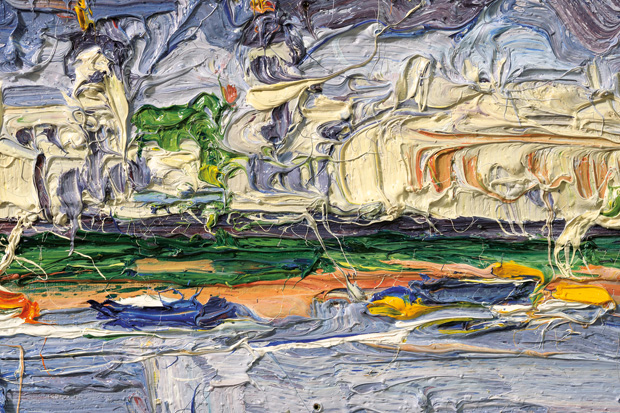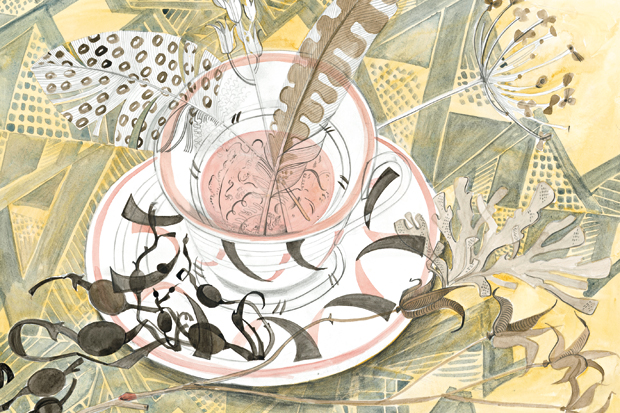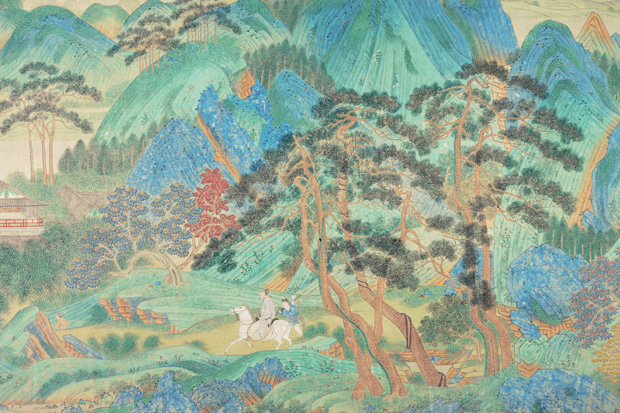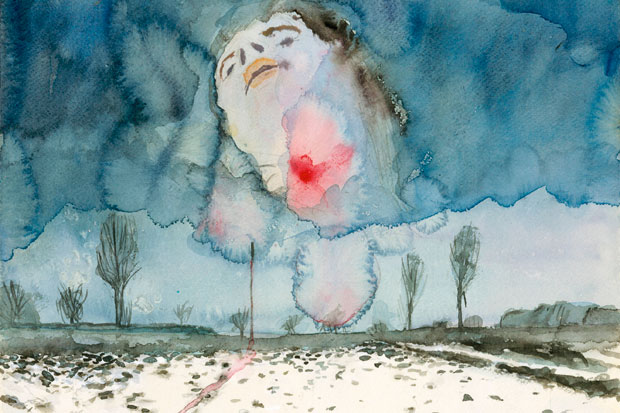The V&A’s remarkable survey of Chinese painting begins quietly with a beautiful scroll depicting ‘Court Ladies Preparing Newly Woven Silk’, from the early 12th century, which, with its bright colours, shallow space and lack of setting, invites comparison with a western masterpiece of a similar date, the Bayeux Tapestry. The crowded urgencies and narrative drive of the English/French embroidered cloth couldn’t be further from the refined intervals and sophisticated relationships of the Chinese scroll, and yet both tell much about the cultures that produced them. However, neither should be read simply as historical documents: both offer rare aesthetic pleasures of quite different distillations. The Chinese elixir seems to me to be particularly effective in landscape painting.
The exhibition is in two halves, subdivided into six successive periods, with the works arranged both chronologically and thematically. The dim lighting conjures a reverential atmosphere suiting the Buddhist devotional images which next appear, though some exhibits are difficult to see in the conservational gloom. For example, the monochrome ‘Reading the Memorial Stele’ remains indistinct though it looks rather appealing in its tentacular frondiness. Here is an interpretation of landscape that is based upon imaginary visions of the sublime and eternal, rather than the real world. Look, for instance, at the ‘Nine Dragons’ scroll (1244), by Chen Rong, a fabulous bit of ink drawing with occasional touches of red, humorous and inventive as well as formally brilliant. (The degree of abstraction here tempts one to christen Chen Rong the master of the curlicue.) The dragons disport themselves among clouds, water and mountains, symbolising the dynamic forces of nature.
Hereabouts are a company of oval or circular vignettes, of which ‘Bare Willows and Distant Mountains’ and ‘Wintry Forest’ are fine examples, though the most memorable for me is ‘Temple Among Snowy Hills’, because of its resemblance to the drawing style of John Craxton. Echoes abound of modern British artists — Adrian Berg is another painter that came to mind as I wandered round this once-in-a-lifetime exhibition, especially when admiring the jewel-like colour and sublime interlocking patterns of ‘Saying Farewell at Xunyang’ by Qiu Ying, from the first half of the 16th century. Poetry and image come together in a group of artists called the literati, who mingled painting, calligraphy and poetry to good effect, though often just this side of preciousness. And when the Chinese began quoting and redoing western Old Masters, the effect could be rather disastrous.
In much of the later work, mountains are piled on each other in what amounts to a mannerism; these paintings simply don’t have the naturalness of the earlier interpretations. Much purer is ‘Bamboo and Rock’ by Zheng Xie (c.1762), influenced by indigenous ancient stone carvings. I thoroughly enjoyed the captivating flow of syncopated forms and accents in ‘Flowers on the River’ by Bada Shanren (1697), depicting the life cycle of the lotus flower from budding through bloom to death, the great scroll ending with the challenging uplands of old age. (The artist was 72 when he painted this great work.) The wonderfully free and brushy handling looks so modern and abstract — which perhaps accounts for Bada Shanren’s late rise to fame. In his own lifetime his work was considered incomprehensible: now it is one of the most radical and innovative images here.
Throughout the show, the quality of drawing and brushwork is astonishing, with stippling a speciality. The structures are eloquent: marvellous shapes that tell so much about the living reality of the thing depicted, as often as not, strongly realised through delicacy, indirection and understatement. A magnificent new volume from Phaidon, entitled The Chinese Art Book (hardback £39.95), usefully puts the whole thing in context by offering a conspectus of visual art (painting, calligraphy, ceramics, sculpture) from ‘the oldest continuous civilisation on earth’, but mixing and matching periods and styles, thus awakening new echoes and correspondences in the process.
Two contrasting approaches to landscape painting as practised over the last century in this country present an intriguing counterpoint to oriental methodology. At Crane Kalman is a scaled-down version of the Graham Sutherland landscapes exhibition that showed over the summer at Abbot Hall Art Gallery in Kendal. Crane Kalman are long-time Sutherland dealers and in partnership with Abbot Hall were able to arrange some fascinating loans.
Works range from one of his finest early etchings, ‘Clegyr-Boia II’ (1938), to a gouache study for the ‘Origins of the Land’ project (1958), ‘Pembrokeshire Landscape’ (1960) and the peculiar but not ineffective late painting, ‘Green Tree Forms’ (1978), like chemical apparatus. There are some very fine early paintings, symbolic rather than descriptive in colour, almost neurotic in their emotional complexity, richly coloured paraphrases of reality, which access the hidden structures and meanings of the natural world. Notice in particular the Picasso-esque ‘Red Tree’ (1936), ‘Landscape with Green Hill’ (1939), and ‘Green Tree Form’ (1940), the last from the British Council Collection.
Meanwhile, George Rowlett (born 1941) proves that plein-air landscape painting can be more than a decorous rehash of Impressionist and Post-Impressionist clichés. His painting goes from strength to strength, employing a hefty but grand build-up of paint on boards he transports out into the Kentish countryside or down to the Thames. Rowlett has a uniquely developed gift of response to the particular character of landscape, whether it’s a river jetty or coastal fishing boats, ripe wheat and poppies or Canaletto’s Greenwich. His luscious surfaces are deeply spread with subtly controlled colour, the drawing with paint as surprisingly precise as a calibrated realist, the joyous application a fundamental celebration of the beauties of the visible world.
Rowlett lays on his paint with passion and authority, a romantic with the discipline of a classical artist, building his pictures from great slabs of pigment run explosively together on the fruitful edge of chaos. A new version or equivalent of the thing seen emerges beguilingly from the maelstrom of marks: pure paint undergoes a sideways shift into concise evocation. In ‘Cliffs at Hope Point, Early Morning Mist and Sun’, Rowlett has produced a masterpiece of such transfiguration. Highly recommended.
Got something to add? Join the discussion and comment below.
Get 10 issues for just $10
Subscribe to The Spectator Australia today for the next 10 magazine issues, plus full online access, for just $10.
You might disagree with half of it, but you’ll enjoy reading all of it. Try your first month for free, then just $2 a week for the remainder of your first year.














Comments
Don't miss out
Join the conversation with other Spectator Australia readers. Subscribe to leave a comment.
SUBSCRIBEAlready a subscriber? Log in